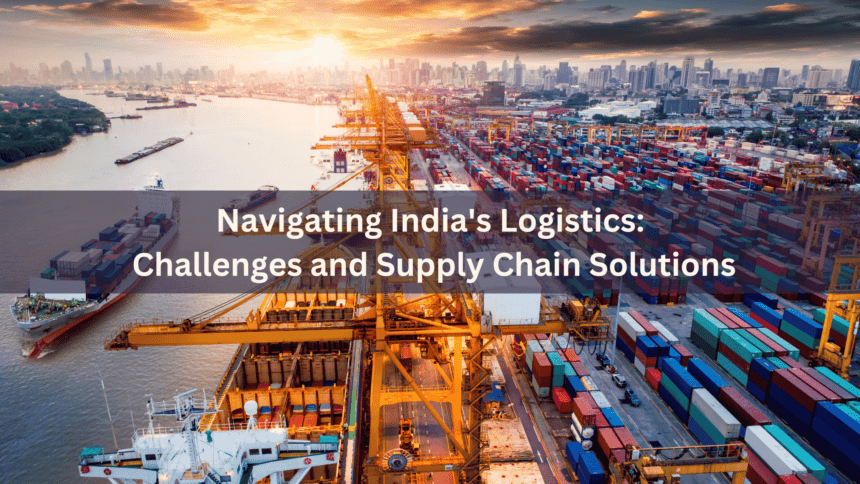Introduction to Logistics and Supply Chain Management in India
In the bustling economic landscape of India, logistics and supply chain management play a pivotal role. The labyrinthine network of transporting goods across vast distances and diverse terrains encapsulates the essence of the nation’s commercial dynamism. Effective logistics management is essential for ensuring the smooth flow of goods from manufacturers to consumers, minimizing delays, and reducing costs.
Historical Context of Indian Logistics
Early Trade Routes and Ancient Logistics
India’s logistical prowess dates back to the Indus Valley Civilization, where trade routes were established to facilitate commerce. The intricate network of rivers and roads enabled the exchange of goods, laying the foundation for modern logistics. Ancient Indian traders navigated through the Silk Road and maritime routes, showcasing early examples of efficient supply chain management.
Post-Independence Developments
Post-1947, India’s logistics sector underwent significant transformations. The establishment of state-owned enterprises and the introduction of Five-Year Plans aimed at bolstering infrastructure marked the initial steps towards a structured logistics framework. The development of national highways, railways, and port facilities laid the groundwork for a more connected and efficient logistics system.
The Current Landscape of Indian Logistics
Key Players and Stakeholders
Today, the Indian logistics sector is a mosaic of government bodies, private companies, and multinational corporations. Key players include Indian Railways, major port authorities, and logistics firms like Blue Dart and DHL. The collaboration between these entities is crucial for overcoming logistics challenges and ensuring seamless operations.
Infrastructure Overview
India boasts an extensive network of highways, railways, ports, and airports. However, infrastructural bottlenecks persist, hindering seamless logistics operations. The National Logistics Policy aims to address these challenges by enhancing multimodal transport infrastructure and promoting the integration of different transport modes to optimize supply chain efficiency.
Major Logistics Challenges in India
Infrastructural Deficiencies
Despite significant improvements, India grapples with inadequate infrastructure. Congested roads, insufficient rail connectivity, and underdeveloped ports contribute to logistical inefficiencies. These infrastructural deficiencies are among the most pressing logistics challenges, leading to increased transit times and higher costs.
Regulatory Hurdles
The labyrinthine regulatory framework poses another challenge. Multiple clearances, state-level taxes, and bureaucratic delays impede the swift movement of goods, affecting overall supply chain efficiency. Simplifying these regulations and creating a more transparent system are essential steps to mitigate these logistics challenges.
The Impact of GST on Logistics
Pre-GST Scenario
Before the introduction of the Goods and Services Tax (GST), India’s logistics sector was burdened with a plethora of state taxes and checkpoints, causing delays and increasing costs. The fragmented tax structure created significant logistics challenges, as goods had to pass through numerous state borders, each imposing its own taxes and regulations.
Post-GST Reforms
GST has revolutionized logistics by creating a unified market, reducing transit times, and lowering costs. The abolition of interstate checkpoints and streamlined tax structure has significantly enhanced efficiency. These reforms have addressed some of the critical logistics challenges, making it easier for businesses to operate across state borders.
Technological Integration in Indian Logistics
Digital Transformation
Digital technologies are reshaping Indian logistics. Blockchain, artificial intelligence, and machine learning are being harnessed to improve transparency, predictability, and operational efficiency. These technologies help in tackling logistics challenges by providing real-time data and enhancing decision-making processes.
Automation and IoT
Automation and the Internet of Things (IoT) are becoming integral to logistics. Automated warehouses, smart sensors, and real-time tracking systems are optimizing supply chain operations. These advancements address logistics challenges by reducing human error, improving inventory management, and ensuring timely deliveries.
The Role of Transportation in Supply Chain Efficiency
Road Transport Challenges
Road transport remains the backbone of Indian logistics, but it faces challenges such as poor road conditions, traffic congestion, and regulatory issues. Addressing these logistics challenges is crucial for enhancing supply chain efficiency. Investments in road infrastructure and the implementation of efficient traffic management systems are essential steps.
Rail and Port Connectivity
Efficient rail and port connectivity is vital for a robust supply chain. India’s Dedicated Freight Corridors and port modernization projects are steps in the right direction, aiming to boost cargo handling capacity and reduce transit times. Overcoming these logistics challenges will significantly enhance India’s competitiveness in global trade.
Warehousing and Inventory Management
Modern Warehousing Techniques
Modern warehousing in India is witnessing a shift towards automation and technology integration. Smart warehouses equipped with automated storage and retrieval systems (AS/RS) are enhancing inventory management. These innovations address logistics challenges by increasing storage efficiency and reducing operational costs.
Cold Chain Logistics
Cold chain logistics, essential for perishable goods, is gaining traction. The development of temperature-controlled storage facilities and transportation is crucial for sectors like pharmaceuticals and food. Overcoming logistics challenges in cold chain management ensures that products reach consumers in optimal condition, maintaining quality and safety standards.
E-commerce and its Influence on Logistics
Growth of E-commerce in India
The e-commerce boom in India has redefined logistics. Companies like Amazon and Flipkart have necessitated the development of sophisticated delivery networks and last-mile connectivity solutions. This rapid growth has introduced new logistics challenges, such as managing high volumes of orders and ensuring timely deliveries.
Logistics Adaptations for E-commerce
To cater to the demands of e-commerce, logistics providers are adopting flexible warehousing, faster delivery options, and advanced tracking systems, ensuring timely and efficient deliveries. Addressing these logistics challenges is crucial for maintaining customer satisfaction and staying competitive in the e-commerce market.
The Role of SMEs in the Logistics Sector
Contribution of SMEs
Small and Medium Enterprises (SMEs) play a vital role in the logistics ecosystem, contributing to last-mile delivery and specialized logistics services. SMEs help in addressing logistics challenges by offering innovative solutions and filling gaps in the supply chain.
Challenges Faced by SMEs
However, SMEs face challenges such as limited access to finance, technology, and skilled labor. Addressing these issues is essential for their sustained growth and contribution to the sector. Providing support and resources to SMEs can help overcome logistics challenges and promote a more inclusive logistics industry.
Environmental Concerns and Sustainable Practices
Green Logistics
Sustainable logistics practices are gaining importance. Green logistics initiatives, such as using electric vehicles and optimizing routes to reduce carbon emissions, are being increasingly adopted. Addressing environmental logistics challenges is crucial for reducing the sector’s carbon footprint and promoting sustainability.
Sustainable Supply Chain Initiatives
Companies are also focusing on sustainable supply chain initiatives, including recycling, reducing waste, and implementing eco-friendly packaging solutions. Overcoming these logistics challenges is essential for building a more sustainable and environmentally responsible logistics industry.
The Influence of Policy and Governance
Government Policies and Initiatives
Government policies and initiatives, such as the National Logistics Policy and Bharatmala Project, aim to streamline logistics operations, enhance infrastructure, and promote multimodal transport. These policies address logistics challenges by creating a more supportive and efficient regulatory environment.
Public-Private Partnerships
Public-Private Partnerships (PPPs) are crucial for bridging the infrastructure gap. Collaborations between the government and private sector are fostering innovation and investment in logistics. These partnerships help in overcoming logistics challenges by leveraging the strengths and resources of both sectors.
Human Resource Challenges
Skill Gaps in the Workforce
The logistics sector faces a significant skill gap. A shortage of trained professionals and drivers affects the efficiency of logistics operations. Addressing these human resource logistics challenges is essential for ensuring the sector’s growth and competitiveness.
Training and Development Programs
Investing in training and development programs is essential to bridge the skill gap. Government and industry initiatives are focusing on upskilling the workforce to meet the demands of the sector. Overcoming these logistics challenges will ensure a more competent and capable workforce, driving the sector forward.
Case Studies of Successful Logistics Models in India
Examples of Effective Strategies
Examining successful logistics models, such as the Mumbai-Ahmedabad Dedicated Freight Corridor and the Delhi-Mumbai Industrial Corridor, provides valuable insights into effective strategies and best practices. These case studies highlight how innovative approaches can address logistics challenges and enhance supply chain efficiency.
Lessons Learned
These case studies highlight the importance of strategic planning, technological integration, and efficient infrastructure in overcoming logistical challenges. Learning from these examples can help in formulating effective solutions to address logistics challenges in other regions and sectors.
Future Trends and Predictions
Emerging Technologies
Emerging technologies like drones, autonomous vehicles, and advanced analytics are poised to revolutionize the logistics sector, offering unprecedented efficiency and innovation. These technologies will play a crucial role in overcoming future logistics challenges and driving the sector’s growth.
Forecasting the Future of Indian Logistics
The future of Indian logistics looks promising, with continued investment in infrastructure, technology, and sustainable practices. As India strides towards becoming a global economic powerhouse, the logistics sector will play a pivotal role in its success. Addressing logistics challenges will be essential for ensuring that the sector can support and sustain India’s economic growth.
For more content follow Humstory.













